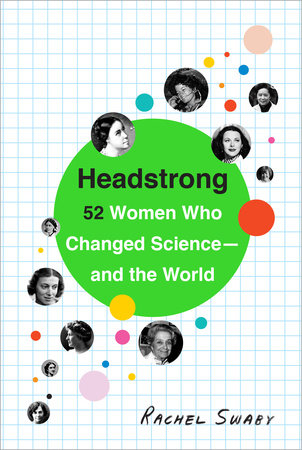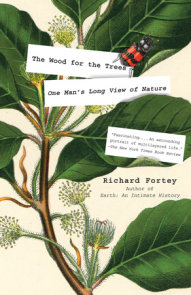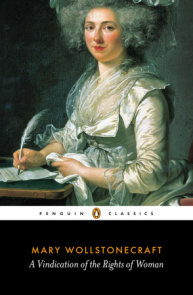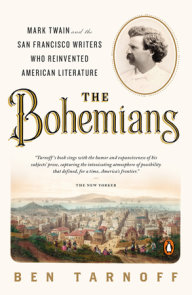TEACHING GUIDE
NOTE TO TEACHERS
Teachers: If you’d like a printable version of this guide, click on the PDF link at the bottom of this page.
About This Book:
When Yvonne Brill, the woman who invented the propulsion system for orbiting satellites, died in 2013 The New York Times published an obituary that began by praising her domestic accomplishments, which include being called “world’s best mom” by her son, “following her husband from job to job,” and making a “mean beef stroganoff”. The fact that she was also a “brilliant rocket scientist” came later. The wording of her obituary sparked a controversy, highlighting the glaring disparity in the way that we profile male and female scientists. In Headstrong: 52 Women Who Changed Science – and the World Rachel Swaby has written short biographies of 52 amazing scientists: one for every week of the year. There are profiles of inventors, mathematicians, physicists, chemists, naturalists, biologists, medical pioneers, astronauts and Nobel Prize Winners – all remarkable scientists who overcame obstacles to pursue their passion for discovery.
Note To Teachers:
As school districts embrace STEM education, a significant problem remains: girls are simply not advancing into higher-level classes, careers or majors in STEM fields at the same rate as their male classmates. An advertisement for the Inspire Her Mind campaign points out the alarming statistic that while “66% of 4th grade girls say they like science and math” only “18% of college engineering majors are female” (the PSA can be viewed here: http://tinyurl.com/m6lxp7y). Although there is not a simple solution to reversing this trend, providing young women with female scientists as role models is undoubtedly a key, and Headstrong: 52 Women Who Changed Science – and the World is a powerful tool that can be used in middle and high school classrooms.
Rachel Swaby’s book is divided into seven sections that highlight different STEM pathways: medicine, biology and the environment, genetics and development, physics, earth and stars, and math and technology, and invention. Each one of the scientists profiled made significant contributions to science – shifting paradigms and, at times, literally changing the way we understand the world. Examining their achievements will teach students in STEM classes about research and the scientific method, providing them with role models of resilience, determination, and grit.
Headstrong is an ideal text to use in STEM programs and multidisciplinary units that span history, science and ELA content. In order to support Writing Across the Curriculum, the questions and activities in this guide have been written with the STEM classroom in mind and aligned with the Common Core Anchor Standards for College and Career Readiness in Writing. The CCSS-CCR Standards correspond by number to grade-specific standards, making this guide adaptable to students in a variety of STEM classrooms and grade levels. CCSS.ELA-LITERACY.CCRA.W.5 will apply to any prompt that is expanded to include all steps of the writing process (prewriting, drafting, revising, editing, publishing).
Before You Read
Engage students in a discussion about role models. Ask students what they think they would like to pursue as a career, and then ask them who they consider to be their role model for this job. How is having a role model helpful (they provide encouragement, inspiration, etc)?
Ask students to brainstorm all the famous scientists and scientific discoveries that they can name. If they have a difficult time thinking of scientists, you may want to use this list as a starting point: http://tinyurl.com/c634t23 and instruct students to circle every scientist that they recognize. Do they know what each of the scientists they circled discovered or theorized? Why is their work significant? How many of the names that they recognize belong to women? Why do they think there aren’t there as many women on the list as there are men?
CCSS: Text Types and Purposes
CCSS.ELA-LITERACY.CCRA.W.1
Write arguments to support claims in an analysis of substantive topics or texts using valid reasoning and relevant and sufficient evidence.
1. Rachel Swaby’s book was inspired by the controversy over the obituary for Yvonne Brill. Read both the original obituary (which can be viewed at http://tinyurl.com/bt98nmh) and the New Yorker’s response (which can be viewed at http://tinyurl.com/pume7mu). Citing evidence from both articles, explain the controversy over the obituary. How do you think journalists should address the issue of gender bias in science reporting? (You may want to have students consider whether or not the think an instrument like the Finkbeiner Test is warranted. An article about the Finkbeiner test and gender bias can be found here: http://tinyurl.com/arm48ze)
2. Consider Swaby’s explanation for the criteria she used to decide which scientists would be included in Headstrong. How did Rachel Swaby select the scientists to include in Headstrong? If you could add one scientist to the book, using Swaby’s existing criteria, which one would you include? Compose a thoughtful argument for their inclusion.
3. When asked if she was bitter that it too so long to be recognized for her achievements, Barbara McClintock (Genetics and Development) responded: “You don’t need public recognition, and I mean this quite seriously, you don’t need it. When you know you are right you don’t care”(99). Do you think that scientists and scientific discovery receive enough public recognition? If you agree with McClintock, explain your reasoning in a well-crafted argument. If you feel that they deserve more recognition, propose a solution to the problem.
4. Many of the women profiled in the book operated as outsiders – lacking the support or approval of the establishment. In STEM fields, is being an outsider helpful, or is it a hindrance? Using details from the lives of the women profiled in Headstrong, compose a thoughtful argument answering this question.
5. Astronomer Annie Jump Cannon said, “My success, if you would call it that, lies in the fact that I have kept at my work all these years. It is not genius, or anything like that, it is merely patience”(160). Why is patience necessary in scientific research? Compose a thoughtful argument using specific examples that illustrate the importance of being careful, methodical, and patient.
Classroom Activity
In the section on Ada Lovelace, Swaby reflects that, “When her name is mentioned today, it’s meant as more than a tip of the hat; it’s a call to arms”(185). Shenhas become an example of female scientists who have not received credit for their contributions. As a class, develop a proposal for a school-wide celebration of Ada Lovelace Day. Present your proposal to the principal and/or academic leadership team and organize an event at your school.
Resources to get you started can be found at http://findingada.com/about/
CCSS.ELA-LITERACY.CCRA.W.2
Write informative/explanatory texts to examine and convey complex ideas and information clearly and accurately through the effective selection, organization, and analysis of content.
1. Many of the women profiled in Headstrong worked collaboratively with other (often male) scientists. Examine the role that collaboration played in the professional lives of one or more of the scientists you’ve studied (ex. Rosalyn Yalow, Ada Lovelace, Emmy Noether). What were the benefits of collaborating? What were the drawbacks? Identify common characteristics of successful and unsuccessful collaborative relationships.
2. Examine the chapters on Chien-Shiung Wu and Alice Hamilton. What lessons can you learn about scientific research, the scientific method, and testing hypotheses from their stories?
3. Consider the importance of parental support in the lives of several of the scientists in Headstrong, specifically comparing the role of parental support in the lives of two different women. Suggested scientists to examine include Maria Goeppert Mayer, Sally Ride, Maria Gaetana Agnesi, Sophie Kowalevski, Irène Joliot-Curie, Ada Lovelace, Hedy Lamarr, and Émile du Chatelet.
4. Rachel Carson write, “We live in a scientific age; yet we assume that knowledge of science is the prerogative of only a small number of human beings, isolated and priest-like in their laboratories. This is not true. Science is part of the reality of lining; it is the what and the how and the why of everything in out experience”(77). Using Carson’s quote as inspiration, create a piece of informative writing that explains the science behind an everyday experience (ex. the science of a fabric that you wear— like Ruth Benerito’s invention of wrinkle-resistant cotton or the arc light at the movies that was invented by Hertha Ayrton).
5. Examine the lives of the scientists profiled in Headstrong. What challenges did they face that were specific to the fact that they were women?
6. One characteristic that has been linked to success is grit. In what specific ways do the scientists profiled in Headstrong demonstrate grit? A great TED talk on grit can be found here: http://tinyurl.com/lb28fpo.
7. The biographies of Anna Wessels Williams and Hilde Mangold highlight the issues the tradition of honoring scientific discoveries by naming them after the scientist raises. What challenges have kept women from being recognized with named discoveries?
Classroom Activity
Inspired by Hertha Ayrton’s 1899 demonstration of the arc light, create a celebration of STEM where you work with a group to create a demonstration experiment for presentation. You may want to look at the work of Elsie Widdowson, Gertrude Belle Elion, Ellen Swallow Richards, Ruth Patrick, Ruth Benerito, and Stephanie Kwolek for experiment ideas. Present your demonstration to an audience, either in person or by recording your demonstration and uploading it to a social media site.
CCSS.ELA-LITERACY.CCRA.W.3
Write narratives to develop real or imagined experiences or events using effective technique, well-chosen details and well-structured event sequences.
1. Physicist Lise Meitner wrote, “Life need not be easy, provided only it was not empty”(129). Compose a personal narrative in response to this quote. How has the study of STEM subjects provided both challenge and meaning to your life?
2. Two of the women profiled in Headstrong, Rachel Carson and Maria Sibylla Merian, combined a love of the arts (writing and painting) with their love of science. Create your own piece of art inspired by a scientific concept or idea. You can choose to explore any genre. You may want to read excerpts from Carson’s writing or view this video of Merian’s art http://tinyurl.com/m2khhw8 as inspiration for your own creation.
3. Gertrude Belle Elion received letters of gratitude from people who benefited from the medical breakthroughs and advances that she discovered. How have you or someone you love benefitted from medical treatment? Write a letter of gratitude to someone in the medical field that has impacted your life or the life of someone you love.
4. One of Virginia Apgar’s strengths was her, “ability to admit her failures and to adapt”(28). Failure is often necessary step in the pursuit of scientific discovery. Compose a personal narrative about a time that you experienced failure. What did the experience teach you? How did you grow as a result of your experience?
Classroom Activity:
As a class, choose one of the scientists profiled in Headstrong and collaborate to create a short theatrical, radio, or video dramatization of her life. Make sure that your dramatization clearly explains both the science behind their discovery and its lasting impact.
Production and Distribution of Writing:
CCSS.ELA-LITERACY.CCRA.W.4
Produce clear and coherent writing in which the development, organization, and style are appropriate to task, purpose, and audience.
1. Listen to Gerty Cori reading her “This I Believe” essay at http://tinyurl.com/lo9g6ll. Compose your own “This I Believe” essay, specifically relating your essay to your beliefs about a STEM topic.
2. Rachel Swaby mentions two examples of people that have written letters to advocate for more inclusive advertising related to women and STEM pathways: Sally Ride’s father, who criticized a financial aid advertisement featuring a male astronaut and 7 year-old Charlotte, who complained to Lego about the gender bias in their marketing. Working in a small group, create an inclusive public service advertisement encouraging both girls and boys to pursue science.
3. Many students have a negative impression of math. What do you think Sophie Kowalevski meant when she said that “it was a mistake of the uninformed to confuse mathematics with arithmetic”(189)? She went on to compare mathematics to poetry. What do math teachers need to do to change the way that students perceive mathematics? Compose a persuasive letter expressing your opinion about the way that mathematics should be taught. Give specific examples to support your position.
4. In the introduction to her book, Swaby explains that she intentionally did not include any living scientists in Headstrong. She goes on to say that, “five years from now, a book with much greater diversity would emerge from the same criteria”. Research a living scientist and write a profile of them in the style of Swaby’s profiles for inclusion in a future edition of the book.
5. In a 2013 New York Times Magazine article, physicist Eileen Pollack commented that there was not a single portrait of a female mathematician hanging up at Yale when she was a student (Introduction). Choose a character trait that you think several of the scientists in Swaby’s book exemplify (ex. courage, determination, intuition, compassion) and create an informational poster using specific details from the lives of the scientists in Swaby’s book to illustrate the character trait. Display your poster in your classroom or in your school.
Classroom Activity
Adapt the biography of one of the scientists profiled in Headstrong into a picture book for elementary-age readers. Choose details from their life that you think will appeal to young readers, and explain the science that they discovered in a way that a child can understand. Share your books with one of your feeder elementary schools or, if you attend a K-12 school, present your book in person to a younger class.
CCSS.ELA-LITERACY.CCRA.W.6
Use technology, including the Internet, to produce and publish writing and to interact and collaborate with others.
1. As a part of Ada Lovelace Day, participants organize and annual “Edit-a-thon” where they write entries for underrepresented female scientists and post them on Wikipedia. This idea has expanded to include Edit-a-thons for women in other underrepresented fields, such as art (for an article about this program, click here http://tinyurl.com/l9w52gn). Research a woman in a STEM field and create a Wikipedia entry highlighting her accomplishments. Make sure that your article reflects a high level of research and scholarship.
2. Many of the women profiled in Headstrong were directly involved in advocating and expanding opportunities for women (for example: Maria Mitchell, Sally Ride, Yvonne Brill, Hertha Ayrton). Unfortunately, access to education for women remains limited in many parts of the world. Research a charitable organization that is advocating for equal access to education and create a PSA highlighting the organization. You may want to upload your PSA to YouTube as a part of the Project for Awesome: http://tinyurl.com/kmpc6po
3. Grace Hopper was a pioneer in the field of technology, and her mantra about the dangers of saying, “we’ve always done it this way,” was adapted by Apple computers for their Think Different campaign http://tinyurl.com/o8oyj93. As powerful as Apple’s advertisement is, it still features a majority of men as examples of people who “thought differently”. Working with your classmates, create a new advertisement based on Hopper’s quote that features an equal number of men and women as examples. Accompany your advertisement with short biographies of each of the men and women that you selected and a statement justifying your decision to include them.
4. As a class, use Google Docs, One Drive, or another document sharing site to collaborate on an annotated bibliography related to books and articles about STEM pioneers. Begin with additional resources related to the scientists profiled in Headstrong, and then expand your bibliography to include other important figures a specific STEM pathway.
Classroom Activity
Analyze the data about the scientists in Headstrong, looking for trends. Which countries produced the most women scientists? Which schools educated and employed the most women? How many Nobel Prize winners are women? How many National Medal of Science winners are female? Use this data to create an infographic (or a series of infographics) for display. Resources related to creating and using infographics can be found here: http://tinyurl.com/com2y92
Research to Build and Present Knowledge:
CCSS.ELA-LITERACY.CCRA.W.7
Conduct short as well as more sustained research projects based on focused questions, demonstrating understanding of the subject under investigation.
CCSS.ELA-LITERACY.CCRA.W.8
Gather relevant information from multiple print and digital sources, assess the credibility and accuracy of each source, and integrate the information while avoiding plagiarism.
1. Several scientists profiled in Swaby’s book made significant contributions to public health and safety (ex: Marguerite Perey, Alice Hamilton, Alice Evans, Rachel Carson, Florence Nightingale). Research the policy or policies that were a result of their research.
2. One of the things that Salome Waelsh was known for was her ability to “contextualize” new scientific findings. Research a recent discovery or emerging area of scientific study and contextualize it by placing in it the context of historical science research and connecting it to your prior understanding.
3. Ellen Swallow Richards pioneered the concept of Home Economics (now known as Family and Consumer Sciences) as an academic subject. Research the history of Home Economics. Did your school teach Home Economics at one point? What was the purpose of these classes? Why did most school districts end these programs? Do you think they should be brought back? Debate this question as a class.
4. One of the recurrent topics in Swaby’s book is that of Jewish scientists fleeing oppression in Nazi Germany. Research the historical impact that Anti-Semitism, both abroad and in the United States, had on the scientific community in America and Europe.
5. Because the women in Swaby’s book were often required to work without pay, they tend to come from families that afforded them a level of financial independence. While there are a few notable exceptions, the majority of the women profiled had the financial means to afford working on research for little or no wages. Research current trends in science education. Are pathways in STEM fields equally accessible by students regardless of socioeconomic status? Are STEM careers pursued equally by students regardless of socioeconomic background? Create a webpage, booklet, or brochure encouraging students to pursue STEM pathways. Present compelling data about the benefits of studying STEM.
Classroom Activity
The question as to whether or not Watson and Crick intentionally stole Rosalind Franklin’s intellectual property continues to interest the public. Research Rosalind Franklin (excellent resources can be found at the Rosalind Franklin Papers site http://tinyurl.com/m7vvgzp and at Nova’s page on Franklin http://tinyurl.com/cvqeh6k ) and use your findings to stage a class debate or mock trial on the question of what happened during the research leading up to the discovery of the structure of DNA and what the consequences should have been.
CCSS.ELA-LITERACY.CCRA.W.9
Draw evidence from literary or informational texts to support analysis, reflection, and research.
1. One of the challenges that female scientists have faced is lack of access to educational opportunities and facilities. In the section on rocket scientist Yvonne Brill, Swaby notes that, “too busy with her day job to devote any on-the-clock hours to a passion project, Brill worked on weekends and late into the night, hunkering down at her kitchen table with pencils, yellow notepads, and a slide rule”(171). Compare Swaby’s profiles of the women in Headstrong to Virginia Woolf’s treatise on women and writing, A Room of One’s Own (a PDF is available here: http://tinyurl.com/opt9dsm). Compose your own version of Woolf’s essay, using examples from Swaby’s text and focusing on the challenges that have been faced by women studying science.
2. Mary Cartwright’s research is a key component of chaos theory. Research chaos theory, and then read Ray Bradbury’s short story “A Sound of Thunder,” which can be downloaded here: http://tinyurl.com/kj3yu9o. Explain how this story incorporates the central tenets of chaos theory.
3. Compare Swaby’s profile of Mary Anning to the profile that Charles Dickens wrote about her (the Dickens profile can be viewed here: http://tinyurl.com/lbqyzfq). How do the profiles compliment each other? What can you tell about each author’s purpose?
4. Choose one of the scientists profiled in Headstrong and complete an extended research project based on her work. Draw information from a variety of reliable academic resources.
Resources
Websites:
The White House’s Women in STEM page: http://tinyurl.com/n6vvpyf
Verizon’s Inspire Her Mind: http://tinyurl.com/m6lxp7y
The Huffington Post’s News Page: Girls in STEM http://tinyurl.com/d4l76cg
Other Titles of Interest:
On a Farther Shore: The Life and Legacy of Rachel Carson, Author of Silent Spring by William Souder
Sally Ride: America’s First Woman in Space by Lynn Sherr
Ada’s Algorithm: How Lord Byron’s Daughter Ada Lovelace Launched the Digital Age by James Essinger
Nobel Prize Women in Science: Their Lives, Struggles, and Momentous Discoveries by Sharon Bertsch McGrayne
Grace Hopper and the Invention of the Information Age by Kurt W.Beyer
Rosalind Franklin: The Dark Lady of DNA by Brenda Maddox
Obsessive Genius: The Inner World of Marie Curie by Barbara Goldsmith
Silent Spring by Rachel Carson
The Immortal Life of Henrietta Lacks by Rebecca Skloot
The Fossil Hunter: Dinosaurs, Evolution, and the Woman Whose Discoveries Changed the World by Shelly Emling
Hedy’s Folly: The Life and Breakthrough Inventions of Hedy Lamarr, the Most Beautiful Woman in the World by Richard Rhodes
Chrysalis: Maria Sibylla Merian and the Secrets of Metamorphosis by Kim Todd
About This Guide’s Writer
Amy Jurskis is the author of a number of teaching guides, including The Immortal Life of Henrietta Lacks by Rebecca Skloot and In the Garden of Beasts by Erik Larson. She holds a B.A. in English from the University of Georgia and a MAT from Agnes Scott College. She currently serves as a chairperson of curriculum and English teacher at Oxbridge Academy of the Palm Beaches.
×
Become a Member
Just for joining you’ll get personalized recommendations on your dashboard daily and features only for members.
Find Out More Join Now Sign In





















